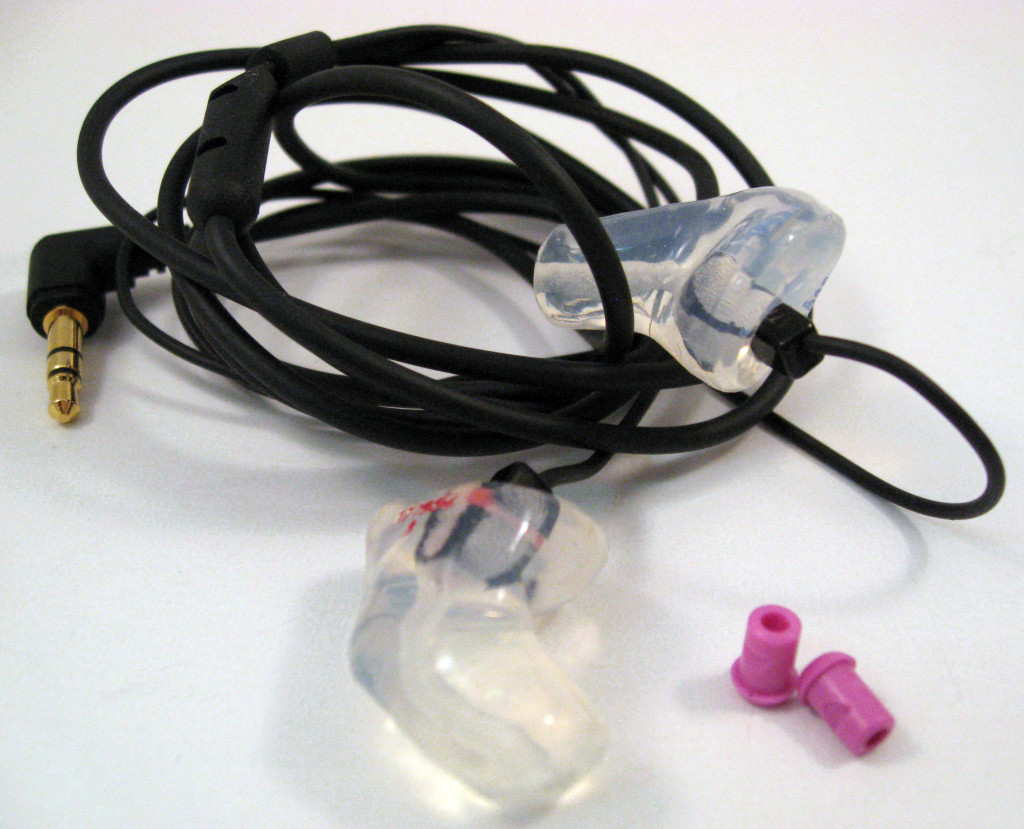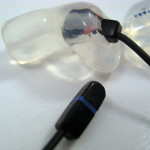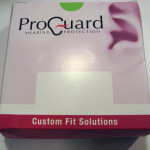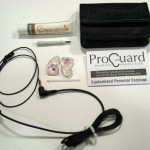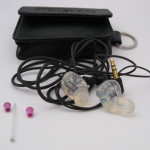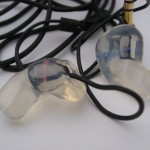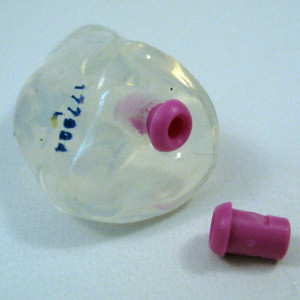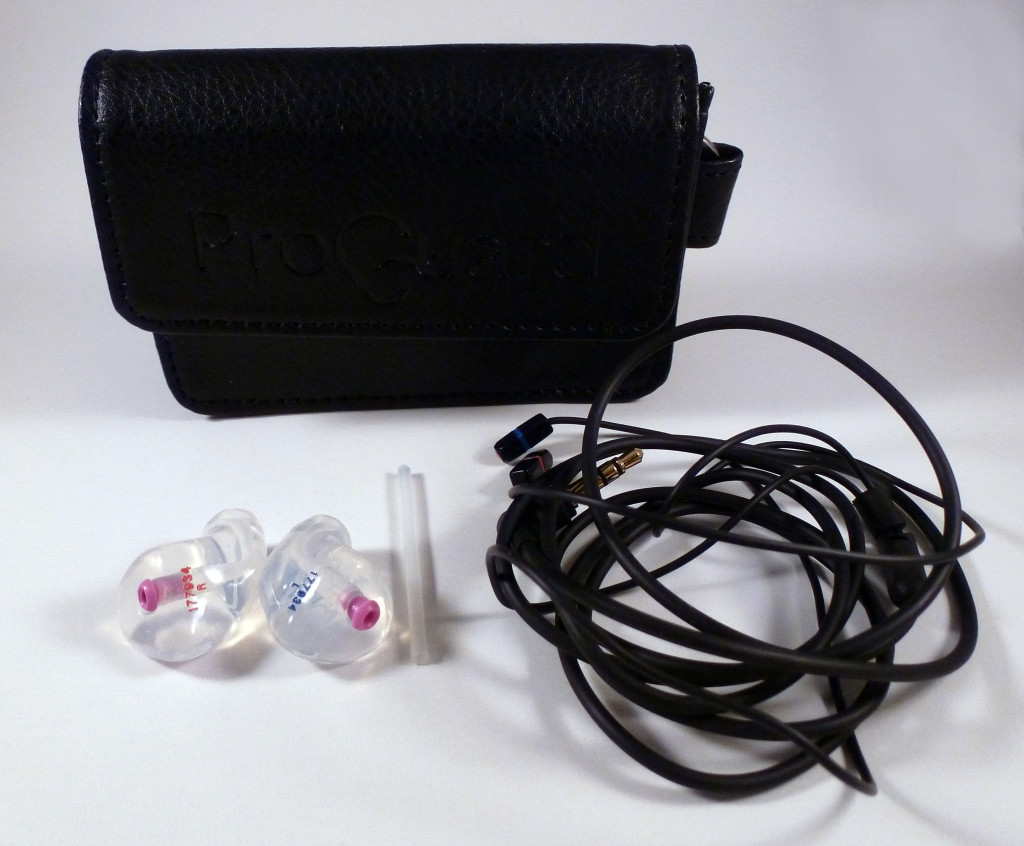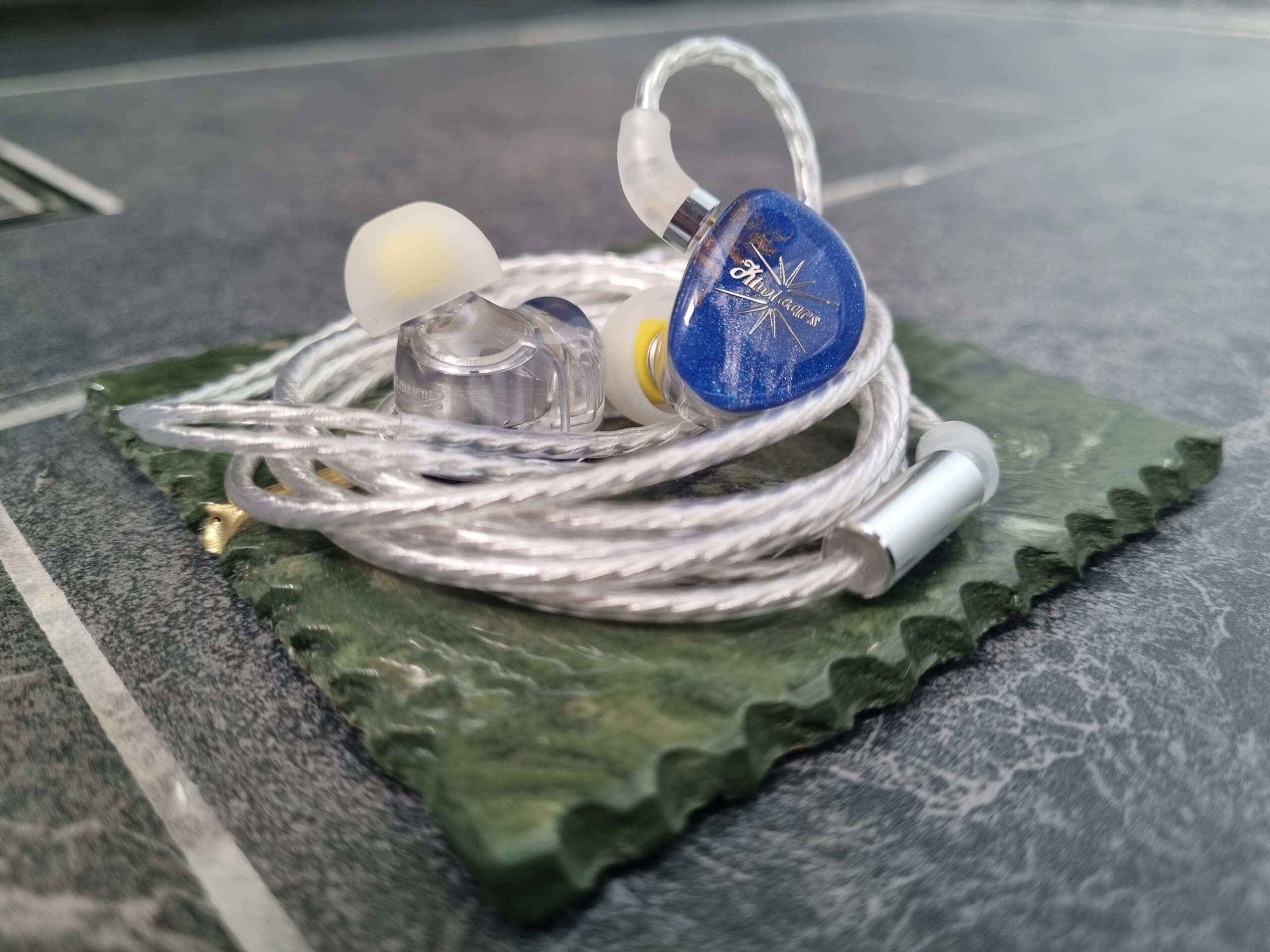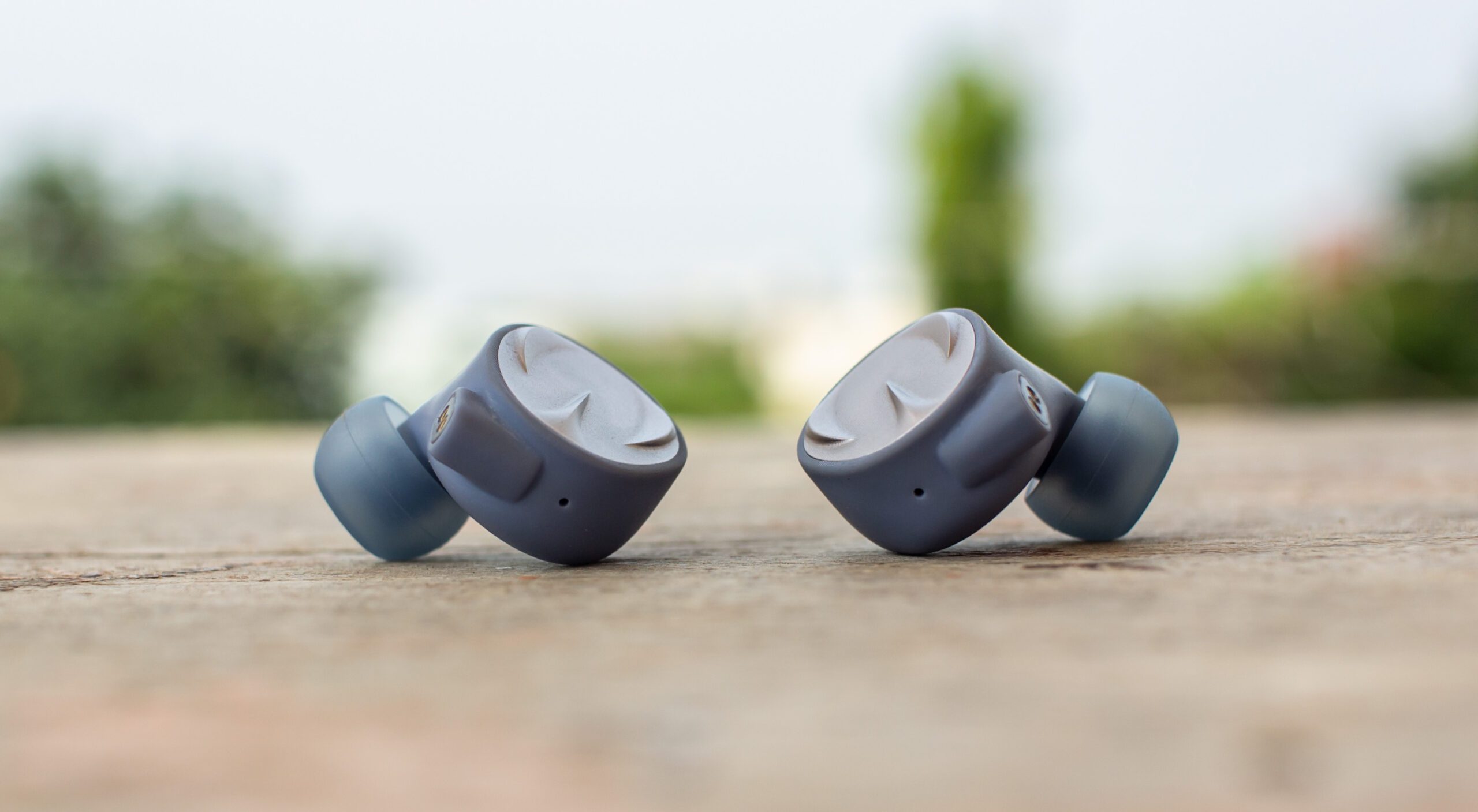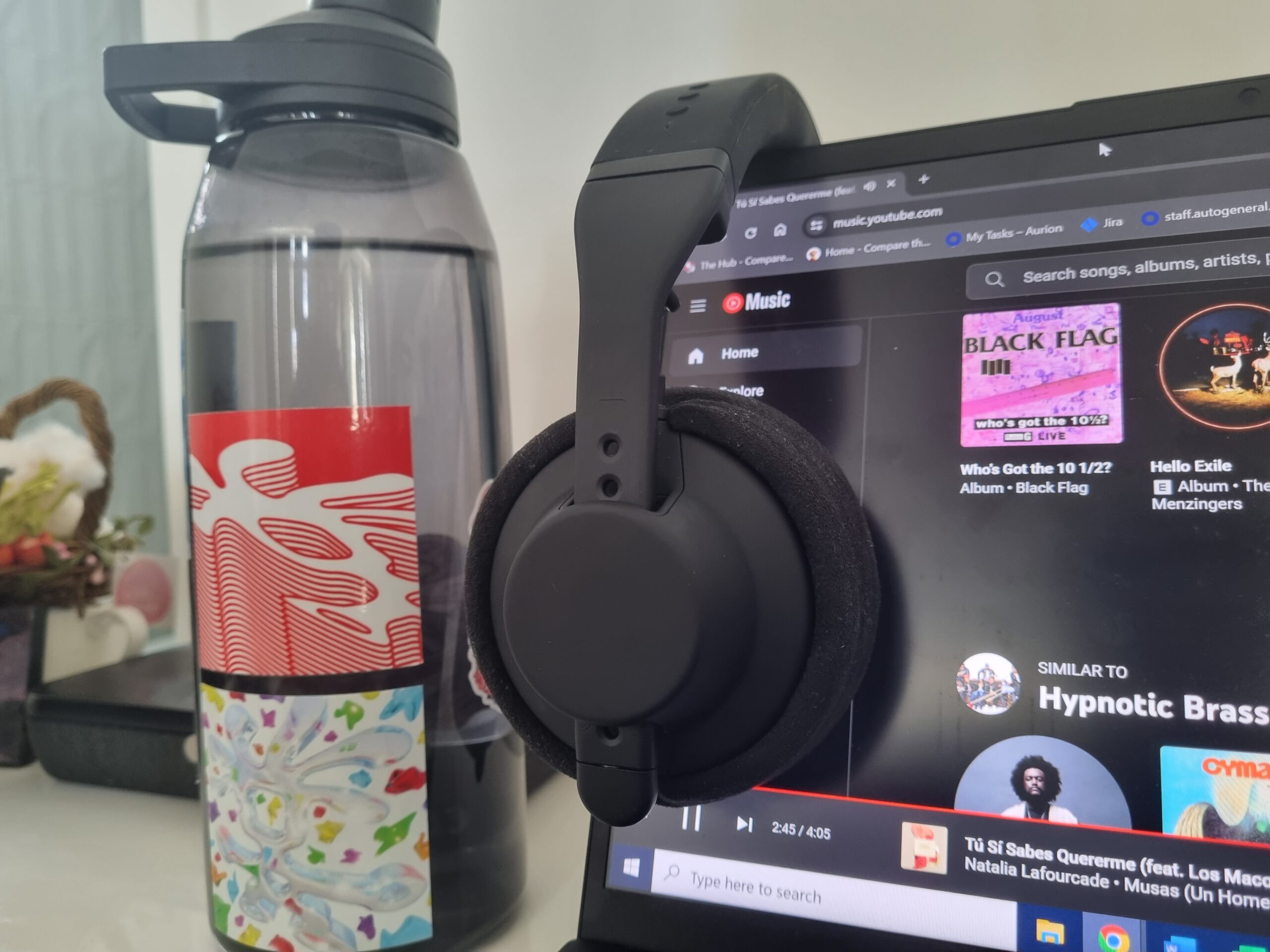Price:
In the UK: £262.80; + 36 for impressions; +£24 for filters
Outside of the UK: With filters – £219 ($362); + £20 ($33) for filters
Country of Origin: United Kingdom
ProGuard Hearing Protection is a part of Sensorcom Ltd run by Rob and Richard (ex–Garwood, original manufacturer of IEM radio systems), both with around 25 years of audio and hearing protection experience. The silicone Fleximonitors are designed to help protect hearing in loud environments while still enabling some sound to pass through, and use interchangeable filters. Silicone is flexible, unlike acrylic shells, typically providing a more comfortable long-term fit, and one that will allow you to eat and talk without breaking a seal.
Made as a canal-only shell, the Fleximonitors provide The Fleximonitors also work with the EarZlug driver units, which use a single balanced armature for a custom fit earphone. This is excellent flexibility and something that comes in handy if you want one custom shell that works for multiple occasions and circumstances.
Here is a great bit about hearing loss taken from the ProGuard marketing material, and something that is so true: “Hearing loss is usually a gradual process due to prolonged exposure to loud sound but other symptoms happen often and people can develop Tinnitus, it starts with a ringing, whistling and buzzing in the ear a distressing condition which can lead to nights of disturbed sleep.” I come across people with hearing loss all the time, and for most people by the time they think about it, it is too late. Educate yourself, and keep reading to hear about my experience with the Fleximonitors in loud environments.
HOW TO ORDER & OPTIONS
ProGuard sells the Fleximonitors on their website and will ship worldwide. Ordering consists of selecting your options and going through the checkout process. VAT will automatically be removed for customers outside of the EU, and Rob will be happy to help with orders. If you order with impressions, select from the list of audiologists here. If you are not in the UK, you will need to send in impressions taken with a 1” bite block. Shipping is via Royal Mail 1st Class and free worldwide. ProGuard accepts PayPal, Visa, and MasterCard.
Options: Ear impressions or no ear impressions. Kit, which includes ear impressions, 17 dB filters, and 33 dB filters.
All available filters include:
- Purple 17dB – Low level attenuation
- Green 24dB – Medium level attenuation
- Orange 30dB – High level attenuation
- Red 33dB – Extreme level attenuation
WARRANTY
1-Year
DESIGN
The Proguard Custom Fleximonitors Mark 2 are canal sized silicone shells that are customized to your ear canal and include the EarZlugs, which are earphones designed to fit in the Fleximonitors. The Fleximonitors have a hollow sound tube that is larger in diameter in back and smaller in the front, allowing either drivers or filters to be inserted in the back and stay in place. The EarZlug is what Proguard called their Interchangeable Insert Driver system (ICIDS) and use a single balanced armature driver for each channel in a tiny plastic housing with a permanent cable. The filters can be purchased with the kit or separately and come in different attenuation levels.
Specifications:
Frequency Response: 15hz – 15kHz
Speaker Type: Single balanced armature driver
Impedance (1KHZ): 50 ohms
Max SPL: 105dB
Cable: Black Kevlar reinforced, 1400mm
ACCESSORIES
ProGuard Fleximonitor Eartips, EarZlug (ICIDS) Earphone system, Cleaning wax brush tool, Wax filter dial pack of 15 including insertion/removal tool and ProGuard Faux Leather storage pouch. Optional 17 dB and 33 dB filters. The accessory pack is nice and sized right, but lacks a special pouch for the filters and removal tool, should you decide to buy them, scoring a 6/10.
CABLE
The permanently attached EarZlug cable is black and has Kevlar reinforcement. It is on the rubbery side of the spectrum, and is fairly tangle resistant. Ergonomically, it works well considering the size of the attached driver, and from my experience, appears like it will have better than average durability. I would rate the overall cable experience a 4/10 due to the memory and rubbery feel.
FIT
The custom fit of the Fleximonitors fits perfectly within my ear canal and is comfortable for extended wear. However, when it comes time to remove them, it is difficult grabbing them for removal, especially considering there is either no cable, or if the EarZlugs were installed, I didn’t want to pull on the cable for removal. I did end up using the EarZlug cables to help remove them, and it worked for one ear, but the driver ended up coming out on the other ear. When the pink filters were installed, the isolation was good, but not enough to prevent me from hearing people, so removal was not necessary. The ProGuard fitting instructions can be found here.
ISOLATION
The isolation is dependent upon what is installed in the shell and rated at 25 dB per the manufacturer. With the driver, the isolation rates around that of an acrylic shelled custom in-ear monitor and not as much as another canal only CIEM, the M-Fidelity SA-12. The filters available include 17dB, 24 dB, 30 dB, and 33 dB. Isolation with the EarZlugs installed was a 3.5/10, offering good, but not great isolation.
FLEXIMONITORS USE AS EAR PLUGS
I don’t normally go clubbing at his point in my life, but I had a friend I hadn’t seen in a long time invite me to a popular club and decided to go. Understanding how loud it can be in the clubs, I decided to take the Fleximonitors with the included 17 dB filters. After arriving on the club level, the music was pumping and LOUD and after talking to my friend for a bit, I proceeded to put the Fleximontiors in to save my ears. Before putting the Fleximonitors in, the music was irritating to me as expected. Once in, the music volume level went from overwhelmingly loud to bearable, and even enjoyable. I did feel a bit odd about wearing ear plugs in a club, especially due to the social situation consisting of many people I didn’t know in the group, but my hearing is important enough to me not to care.
At one point, someone two seats down from me was trying to talk to me and I had no idea until the person next to me tapped on my shoulder to let me know. The person next to me, whom I could hear perfectly, asked about my ear plugs, and I explained they are protecting my ears. He told the person next to him I was wearing ear plugs to a response of “oh, so that’s why you couldn’t hear me.” As the night worn on, I realized that wasn’t the case as when I took them out I still had trouble hearing people further away due to the noise pollution. I was not alone, as when I tried to talk to the person two seats away when their head was turned, they couldn’t hear me at all either.
I decided to use my dB meter app on my iPhone, DecibelMeter, to see the volume level, although I am not sure of the app accuracy. The average was reported as 105 dB and the peak was continuously maxed at 110 dB. (After that experience I have downloaded an app that measures up to 120 dB for any future events.) While this is far from scientific as the measurements aren’t calibrated, it was extremely loud in there, and 105 dB seemed like it actually may be low, but then I try to avoid really loud events, so I can’t say for sure. OSHA lists 1 hour at 105 dB while NIOSH lists 15 minutes at 100 dBA and 0 minutes at 112 dBA. dB is an absolute measure while dBA is an adjusted number based on human perception. How you feel about very loud environments is up to you, but just remember that hearing loss is permanent.
To summarize my club experience:
– I could easily hear people next to me talking, and they were actually clearer because the other sounds were being attenuated.
– While I couldn’t hear people a few people away, they couldn’t hear me either due to the loud, continuous music.
– My hearing was being protected and the adjusted volume was enjoyable to me.
The Fleximonitors proved their worth to me and I highly recommend them for loud events, especially those that you want to turn the volume down and still be able to enjoy. The 17 dB filter worked well for this club experience, and their still allowing me to hear people next to me with better clarity was brilliant!
Later I tested the Fleximonitors while using loud power tools with similar results. The tool noise was significantly reduced to a much more bearable level while I could still hear outside noises, including my family when the tools were off. Sounds from a distance were still muted quite a bit, so my family members had to come closer to me to have a conversation and yelling in the distance may go unnoticed, but the overall experience with the Fleximonitors was excellent.
SOUND – FLEXIMONITORS WITH EARZLUGS
Disclaimer: My review is done in a comparative way using similarly priced IEMs and/or CIEMs for perspective and to determine performance. In this review I try to accurately portray the product under review, presenting strengths and weaknesses, the sound signature, characteristics, and technical performance as opposed to providing flowery dialog of performance without perspective. My ultimate goal is to enable you to make an informed decision about what product is right for you. Take the review as a critical look at the product and not a sales pitch or marketing fluff. I believe gear should be selected based on the sound signature you want and/or the specific use, not solely on technical performance or unsubstantiated hype. Here are some quick references for more information: My review technique, Thoughts on reading a review, Custom IEM information
The Fleximonitors received 100+ hours of burn in as is customary before I do my serious listening. The following custom IEMs were used for comparison:
Bass: The overall sound of the EarZlugs is on the darker side, but it isn’t due to an overload of bass. The bass is adequate; not great and not poor and in line with other single balanced armature driver earphones such as the Custom Art Music One and the MEElectronics A161P. The bass output is quite dependent upon the source, as quality amps offer a significant boost to bass performance, but even with a good amp don’t expect great depth or massive reverb. Dual armatures such as the In Earz IE-P250 and ProGuard’s P2+1 surpasses the EarZlugs performance by a good margin. Overall, bass is tight, well controlled, and fast for a clean experience.
Midrange: The midrange is forward and clean, however there isn’t a lot of layering, leaving the overall sound a bit flat compared with the Music One and more expensive competition such as the EarSonics SM64. Detail levels are higher than most dynamic driver earphones, but still not to the level of dual drivers I have heard. Tonally, vocals sound organic and natural, if a bit on the darker side of the spectrum. For a single driver, there are no complaints.
Treble: Present but significantly relaxed, the treble is there but not dominant. Due in large part to the laid-back treble, it is very non-offensive. Overall quality is an improvement compared with something such as the brighter and harsher A161P, but not vs. the single driver Music One which has better decay and detail retrieval. Extension isn’t great, but not out of the ordinary for a single full range balanced armature driver.
Presentation: The EarZlugs has an analytical sense to it like many single balanced armature driver earphones, but has a darker tone than most. Spatially the EarZlug exhibits good proportions and images well, the overall space isn’t large, not offering performance of many universal monitors at the price point. Clarity is okay, but not great, and complex tracks can sound a bit congested, not unlike other single BA earphones. Transparency is adequate and dynamics acceptable, as the presentation doesn’t do anything to stand out and be memorable, but isn’t offensive in any way. There is a focus on the midrange, with both the bass and especially the treble pushed to the back respectively.
Volume performance: The EarZlug performs well at all tested volume levels, and has a limit of 105 dB per the manufacturer. Due to the limited bass capabilities, I didn’t experience any distortion issues, and the clarity remained relatively constant through the various volume levels. Bass didn’t change much at very low volumes.
Sound Summary: With a mid-forward presentation, the EarZlugs are reminiscent of many single balanced armature driver earphones with better detail retrieval and a more analytical sound than a dynamic driver earphone. Bass is tight and present, but won’t satisfy bass heads. The laid-back treble is forgiving, smooth, and detailed, but the presentation hides some of the detail. Imaging is good, but the overall soundstage size isn’t the biggest, which when combined with the treble presentation doesn’t give all that open of a sound. But, the EarZlug is a solution that is more about an overall package and convenience instead of absolute sound quality.
COMPARISONS
Custom Art Music One: The Music One sounds brighter, more open, and airy with better clarity. The presentation is similar through the bass and midrange, especially in vocal placement and warmth, but the Music One presents with more space. The upper midrange and treble are divergent as the Music One is more forward while sounding cleaner and more precise. Speed and dynamics are better with the Music One, and while detail levels are somewhat similar, the Music One does present more detail and a better sense of ambiance, with further projection ability, adding more realism to music playback.
It is apparent the EarZlug are designed for stage professionals as the relaxed treble is more reminiscent of traditional stage sound while the Music One is tuned for music enjoyment.
In Earz IE-P250 (review upcoming): The EarZlug has a darker tone than the P250, which presents with more authority, spaciousness, and clarity. The P250 extends further on both ends and has significantly more bass rumble. Detail levels are higher on the P250 and are articulated better with improved clarity and refinement. While the P250 has more depth and width to the presentation, it is also more forward. The performance difference are significant between these two, but they are similar in the overall musicality.
EarSonics SM64: The SM64 is brighter with more detail with a clearer overall sound, better dynamics, and a larger presentation space that is much more 3D. Dynamics are better with the SM64, as is detail levels and resolution. With a much more forward midrange, the EarZlug brings vocals closer to you, making the SM64 sound V-shaped in comparison. The treble of the EarZlug is smoother and doesn’t fatigue the ear like the SM64 can in comparison, but the bass of the SM64 is much more prominent and capable, imparting a much different flavor on music.
MEElectronics A161P: The A161P is brighter with less emphasis in the bass region and a slightly more forward, smaller presentation. The treble of the EarZlug is smoother and more refined as the A161P treble can sound harsh in comparison. Bass is more visceral on the EarZlug with more impact while the A161P punches faster and harder. The midrange of the EarZlug is slightly cleaner while the A161P is clearer due to the added brightness. The presentation space favors the EarZlug, with a slightly larger and more 3D space and is more musical overall.
With very different price ranges and target audiences, the EarZlug and A161P both offer precise sound with similar strengths, but the EarZlug does offer more in terms of overall performance and flexibility.
SOURCE MATCHING
Portable Sources, DAPs
Sandisk Sansa Clip+: This combination is rather dark, although the bass isn’t too deep and there is a bit of sibilance. Compared with the iPhone 5, the matching is relatively poor. 2/10
Apple iPhone 5: The iPhone 5 is more detailed, smoother, and more natural sounding than the Clip+, with more treble presence and deeper bass. The overall sound isn’t a large step up from the Clip+, but it is a step up. 4/10
Hisoundaudio Nova 3: The Nova is a bit smoother and more natural in the upper midrange area while the bass isn’t quite as impactful as the iPhone 5. The sound is overall more musical, intimate, but also just as spacious. 6/10
Fiio X3:The X3 has a bit more spacious sound than the Nova, but is also more mid-forward. Bass presence is close, with the Nova having slightly less bass presence. 6/10
iBasso DX50: The DX50 presented with a bit thicker sound compared with the Nova 3 and AK120 that reduced clarity and gave a darker overall presentation. 5/10
Astell & Kern AK120: The AK120 is brighter clearer, and more open sounding than the DX50, but the sound was about on par with the Nova 3, although a bit more refined. 7/10
iBasso DX100: The DX100 is clearly a step up in the sound quality department compared with the other sources, improving the entire spectrum, adding space, and imaging better. Bass is more impactful and seems to hit a bit deeper. With well mastered tracks, this pair can sound very good for what it is. 10/10
DAC -> Amps
JDS ODAC ->
Sunrise AM-P1 Dolphin: The Dolphin is a more neutral amp, and the combination lacks bass impact and depth for tonal performance that is not necessarily brighter, but shifted to the upper midrange/lower treble. Other qualities aren’t anything special. 3/10
Neco V2: The V2 I more musical and natural sounding than the Dolphin, making for an excellent combo with more bass oomph and a better tonal balance to go along with a more spatial presentation. 6/10
Shonyun SH-306A:The 306A has a bit better bass impact and quantity than the V2, but gives up spaciousness. The overall sound is cleaner and clearer, if just by a bit. There is a low level hiss with this combination. 6.5/10
JDS O2: The O2 has good space and depth of the presentation, although not to the level of the DX100. Bass is good considering the EarZlug is a single driver, but the overall sound is harsher than the 306A and V2. 5.5/10
Source Summary: The EarZlugs are quite dependent upon the amp section of the source feeding them. Their performance level isn’t too high, but a better source will result in better bass performance and a bit more space and imaging, however I wouldn’t say the expenditure on an expensive source for the sole purpose of driving the EarZlugs would be worth it. The sound is OK from an iPhone, but there is more potential if paired with an amp.
SUMMARY
The ProGuard Fleximonitors Mark 2 are a good combination product that offers both hearing protection and the ability to playback audio in a relatively easy to use product. The filters reduce noise pollution in loud environments while still allowing conversation with people close to you, which I found to be an excellent benefit for my hearing health. The included EarZlugs use a single balanced armature driver for each channel, providing an analytical, detailed sound with performance representative of single BA driver earphones. There is a darker tone inline of musicians monitors that will resist listening fatigue.
Considering the versatility, the Fleximonitors are a “must have” product for me when I know I will be in a loud environment and want to be able to converse with others. The audio playback ability is icing on the cake, and allows me to travel extra-light whenever I want.
Pros
– Ability to use the Fleximonitors with EarZlugs or filters
– Comfortable silicone shells with a minimalist size
– Unlike ear plugs, the filters allow some sound in, protecting hearing while allowing for conversation
Cons
– Difficult to remove due to the canal only design
– Sound quality of the EarZlugs is average

